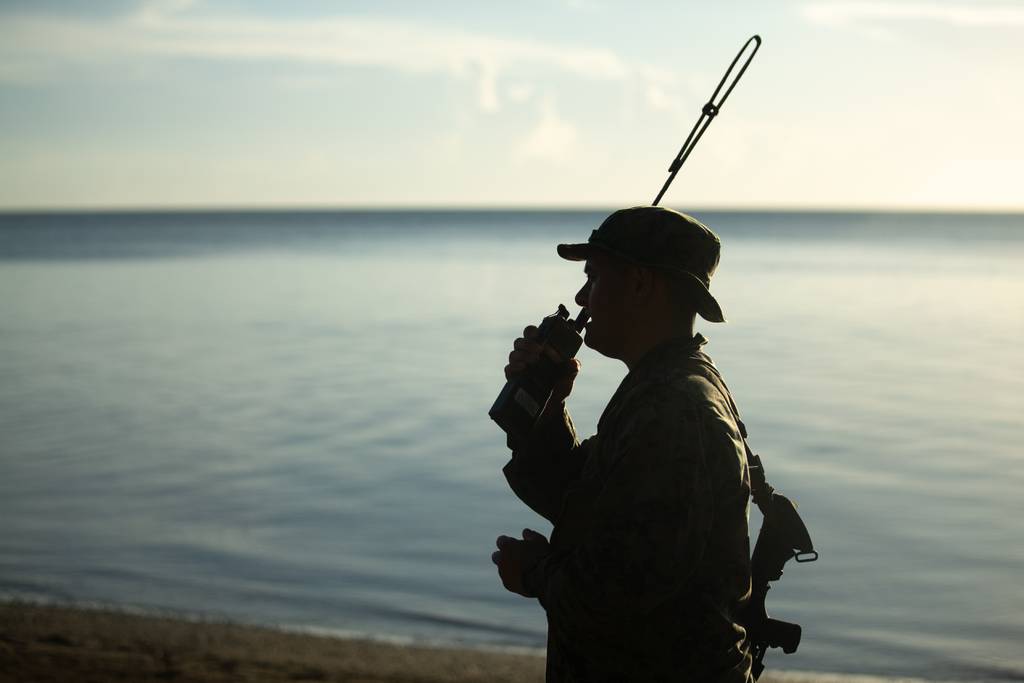:quality(70)/cloudfront-us-east-1.images.arcpublishing.com/archetype/R4SWFLA7Y5HDNB224JGPQOA74A.jpg)
WASHINGTON — A pair of U.S. Marine Corps exercises in the Pacific this month focused on working side-by-side with allies as the Marines pursue more sophisticated ways of sensing coastal waters and picking out targets.
The 3rd Marine Division commanded forces in two separate exercises, Resolute Dragon in Japan and Kamandag in the Philippines, that both questioned how Pacific Marines could quickly disperse to key maritime terrain and then team up with local forces to find and hit threats ashore and at sea, exercise leaders told Defense News.
While the two exercises had different objectives, 3rd Marine Division leadership coordinated their deployment from Okinawa, Japan. Division leadership also picked times to coordinate actions across both exercises, simulating the kind of disaggregated fight the Marine Corps expects in the future.
Kamandag was set in some of the most vital locations in the Pacific if the U.S. were ever called upon to defend Taiwan. Marines departed Okinawa and spread out throughout the Philippines, operating in locations on the western island of Palawan, near capital city Manila, in remote jungle in northern Luzon, and in small islands between the northern Luzon shore and Taiwan.
One island involved in the exercise, Basco, is about the same distance from Taiwan’s southern shore as Naval Station Norfolk, Va., is from Marine Corps Base Camp Lejeune, N.C.
Some of the exercise events focused on command and control and sensing the battlefield alongside Philippine Marine Corps units, while others included bilateral combined arms events.
In northern Luzon, the goal was to “become familiar with the terrain that we might operate off of with our allies in a crisis, and also develop the necessary understanding of what the sustainment and resupply situation would be for us in areas like that,” Col. Erick Clark, commanding officer of 4th Marine Regiment under 3rd Marine Division, told Defense News.
Resolute Dragon, which this year took place on the northern island of Hokkaido in Japan, was focused on operating Bilateral Ground Tactical Coordination Centers, according to Col. Jonathan Sims, commanding officer of 12th Marine Regiment under 3rd Marine Division.
Sims, who has spent several years operating alongside the Japanese, said U.S. and Japanese units often have liaisons in each other’s operations centers to ensure they have matching operational pictures, but he said the effort gets quite “unwieldy.”
In recent years, the two militaries have crafted a concept for these bilateral coordination centers; due to the COVID-19 pandemic, Resolute Dragon 22 was the first exercise testing the concept on a larger scale, Sims said.
For the 12th Marines, he said, “we don’t do anything without Japanese partnership, nothing. And so really the imperative here was that we go out and start to run our operations together, absolutely side by side.”
The next step will be to move this type of exercise to more tactically relevant locations, including the islands between mainland Japan and Okinawa, and the islands between Okinawa and Taiwan.
For both exercises, the first test was arriving at the locations on time.
“What we continually see is that there’s just not enough military-tagged Department of Defense lift to move the division and my regiment to where it needs to go in a contingency or crisis,” Sims said. 12th Marines traveled to Hokkaido via civilian lift and Military Sealift Command ships.
He said the deployment went smoothly, though ships like dry cargo ship Sacagawea and roll-on/roll-off ship Dahl might not be available during an actual fight. Sims said his unit must consider other options to ensure it can always deploy when needed.
“We have to solidify plans to be able to get there as early as possible and then be able to partner up with our allies, whether it’s Japanese, Filipinos or otherwise,” Sims said.
The Marines headed to the Philippines used a range of military ships and aircraft, including amphibious assault ship Tripoli.
A forward command element from 3rd Marine Division even rehearsed scrambling from its Okinawa headquarters to the Philippines as part of an Alert Contingency Marine Air-Ground Task Force Drill using U.S. Marine Corps KC-130J planes, spokesman Lt. Col. Kurt Stahl said, part of an effort to ensure this lift is ready on short notice.
Once there, part of the Marines’ challenge was applying new gear to the rugged environments.
Clark said the jungles of northern Luzon stressed the radars and small unmanned aerial systems the Marines typically use to sense the environment and look for targets.
These systems were developed and tested in the United States, but 4th Marines needed to use them in the heat, humidity and triple canopy jungle. Clark said his Marines learned about employing these sensing capabilities in tough weather and terrain and would use those lessons to refine how they gather, process and share information.
Clark noted Marines near Manila for Kamandag and in Hokkaido for Resolute Dragon used High Mobility Artillery Rocket System launchers, something of great interest to the Philippines and Japan as they modernize to conduct littoral operations in a similar manner to the U.S. Marines. He said Japan has a shore-based anti-ship system, and the Philippines is interested in pursuing a coastal defense sensing and fires system.
“As we work with them, what’s a little more difficult … than developing the technology is developing credible processes in order to employ them in a timely manner that will be relevant to the speed of the battle,” Clark said. “What you saw up in Hokkaido with 12th Marine Regiment working with their adjacent Japanese Self Defense Force, and then with the 3rd Marine Division down in the Philippines, is really how we work these processes, how we go from finding a target to addressing that target, and how we take those lessons learned and cycle them back into the joint force.”
Sims said understanding the flow of information is key — which is why the bilateral coordination centers are manually inputting information for now. He said Resolute Dragon helped each ally understand how the other obtains, inputs and shares information.
The coordination centers will eventually pull all sensor information into a single digital common operating picture for U.S. and Japanese forces to share — a goal 3rd Marine Division set for 12th Marines — but that will require additional maturation of processes and equipment.
Even as this pair of exercises worked through developments in procedures, concepts and tech, Sims said the cultural element was most critical. It’s an effort to ensure that “any time we plan to do something, any time we go out and execute, any time we’re operating or training, that’s its partnered.”
“Out here, where it’s an imperative that we partner, the III [Marine Expeditionary Force] and particularly 3rd Marine Division understand that we have to build a culture of interoperability,” Sims said. “That’s the future.”
Megan Eckstein is the naval warfare reporter at Defense News. She has covered military news since 2009, with a focus on U.S. Navy and Marine Corps operations, acquisition programs and budgets. She has reported from four geographic fleets and is happiest when she’s filing stories from a ship. Megan is a University of Maryland alumna.








